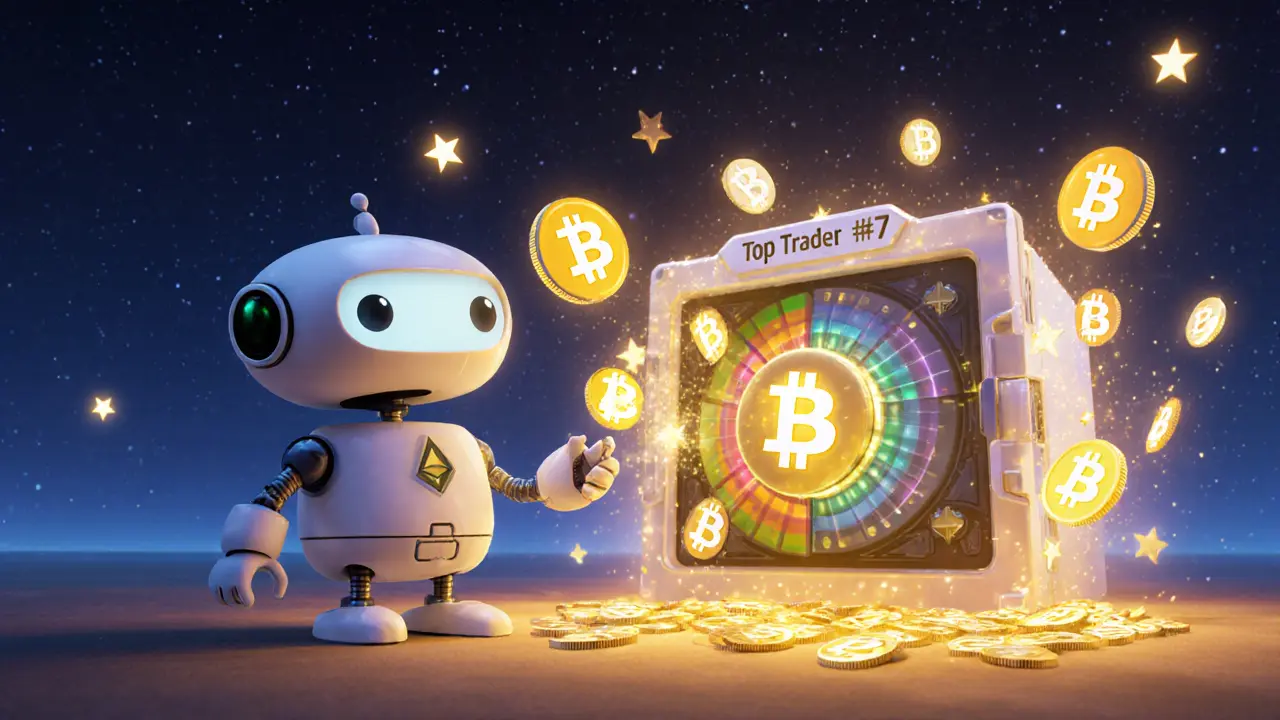RAI Finance Crypto Exchange Review: Social Trading in DeFi Explained

Vault Performance Estimator
Estimate Vault Performance
Estimated Performance
Note: This calculator shows potential results based on historical performance. Actual results may vary due to market conditions, liquidity issues, and the factors discussed in the article.
Key Considerations
- Liquidity Risk: High slippage (over 0.5%) can significantly impact returns.
- Strategy Risk: Historical performance doesn't guarantee future results.
- Smart Contract Risk: No insurance against platform vulnerabilities.
- Volatility: Market conditions can change rapidly.
RAI Finance isn't a crypto exchange like Binance or Coinbase. If you're looking to buy Bitcoin with a credit card or trade Ethereum in seconds with a simple interface, you won't find that here. RAI Finance is a decentralized finance (DeFi) protocol built for social trading - a niche but powerful idea that lets you copy the trades of experienced investors automatically. It’s not for everyone, but if you’ve ever wished you could just follow a pro trader’s moves without learning technical analysis, this might be worth your time.
What RAI Finance Actually Does
RAI Finance operates on a model called social trading. Instead of you deciding when to buy or sell, you follow pre-built trading strategies called “vaults.” These vaults are created by other users - often experienced traders - who set rules based on price ratios, like “buy ETH when ETH/BTC drops below 0.025 and sell when it hits 0.035.” The protocol uses oracles to pull real-time data and executes trades automatically using automated market makers (AMMs).
Think of it like YouTube’s subscribe button, but for trading. You pick a vault that matches your risk level, deposit your assets, and let the system do the work. When you want out, you redeem your share in USD-equivalent value. No need to watch charts, no need to time the market. You’re outsourcing your trading decisions to someone else’s strategy.
Unlike Uniswap or SushiSwap, which are basic token swap platforms, RAI Finance adds a layer of human intelligence. It’s not just liquidity pools - it’s curated performance. The protocol is built to work across multiple blockchains, especially Polkadot, which helps reduce fragmentation. That means you can trade assets from different chains without jumping between apps or dealing with complex bridging tools.
The SOFI Token: Power Behind the Platform
RAI Finance’s native token is SOFI. Right now, it trades around $0.000147. That means for $1, you can buy over 6,800 SOFI tokens. It’s not a high-value coin, but that’s typical for early-stage DeFi governance tokens. SOFI isn’t just a trading asset - it’s your voice in the protocol.
Token holders can vote on key decisions: changing trading fees, adjusting how liquidity mining rewards are distributed, or even approving new vault templates. This makes SOFI a true governance token, not just a speculative one. If you’re serious about using RAI Finance long-term, holding SOFI gives you influence over how the platform evolves.
As of late 2025, SOFI’s market cap sits at just over $2 million. That’s tiny compared to giants like Uniswap ($1.2B) or Aave ($700M). It’s ranked #1876 on CoinMarketCap. That low ranking isn’t a red flag - it’s a signal. You’re not investing in a mature product. You’re betting on whether social trading can catch on in DeFi.
How It Compares to Other Platforms
Let’s break down how RAI Finance stacks up against the alternatives:
| Feature | RAI Finance | Uniswap / SushiSwap | Binance / Coinbase |
|---|---|---|---|
| Type | Decentralized social trading protocol | Basic AMM DEX | Centralized exchange |
| Trading Approach | Copy vaults from top traders | Manual swaps only | Manual trading + basic tools |
| Cross-Chain Support | Yes (Polkadot-focused) | No (Ethereum-only) | Yes (multi-chain) |
| Learning Curve | Medium (DeFi knowledge needed) | Low to medium | Low |
| Liquidity | Low (small user base) | Very high | Extremely high |
| Best For | Users who want automated strategy copying | Basic token swaps | Beginners and high-volume traders |
RAI Finance fills a gap that neither centralized exchanges nor basic DEXs cover. Binance gives you tools to trade manually. Uniswap lets you swap tokens. But only RAI Finance lets you subscribe to a trader’s entire strategy and have it run for you.
That said, low liquidity is a real issue. If you try to move more than a few hundred dollars in a single trade, you’ll likely face high slippage - meaning you get less than you expected. That’s why RAI Finance works best for smaller investors or those testing strategies before committing big amounts.

Who Is This For?
RAI Finance isn’t for people who want to buy Bitcoin with a debit card. It’s not for casual investors who check their portfolio once a month. It’s for people who:
- Understand what a crypto wallet is and how to connect it to a DEX
- Are comfortable with gas fees and blockchain delays
- Want to learn from successful traders without becoming traders themselves
- Believe in DeFi’s potential but don’t have time to analyze every price movement
If you’re new to crypto, start with Coinbase or Binance first. Learn how wallets work, how to send ETH, and how gas fees behave. Once you’re comfortable, then explore RAI Finance. Jumping in without basics will lead to confusion - and possibly losses.
Getting Started With RAI Finance
Here’s how to begin:
- Get a Web3 wallet like MetaMask or the Binance Web3 Wallet.
- Buy some Ethereum (ETH) or DOT (Polkadot) on a centralized exchange like KuCoin or Binance.
- Send those tokens to your wallet.
- Go to the RAI Finance website and connect your wallet.
- Swap some ETH or DOT for SOFI tokens on their built-in DEX.
- Browse available vaults. Look at their historical performance, risk rating, and trader profile.
- Deposit your assets into a vault you trust.
- Monitor your position. You can withdraw anytime, but remember: withdrawals are in USD-equivalent value, not the original asset.
It’s not plug-and-play. There’s a learning curve. The documentation is technical. The interface isn’t as polished as Binance. But if you stick with it, you’ll see how powerful it is to replicate a trader’s decisions without doing the research yourself.

Risks and Challenges
RAI Finance isn’t risk-free. Here’s what you need to watch:
- Strategy failure: Just because a vault performed well last month doesn’t mean it will next month. Markets change. Strategies break.
- Liquidity risk: Low trading volume means big price swings on larger trades. Don’t put in more than you’re willing to lose.
- Smart contract risk: It’s code. Bugs happen. Audits are limited - the protocol hasn’t been fully audited by a top-tier firm like CertiK or Trail of Bits.
- Regulatory uncertainty: Social trading could attract attention from regulators. If the SEC or EU moves against copy-trading platforms, RAI Finance could be affected.
- Community dependence: The whole system relies on skilled traders creating good vaults. If no one builds strong strategies, the platform stalls.
That said, RAI Finance has institutional backing. In 2020, it raised $1.5 million from GBIC and Alphabit Fund, and later got support from NGC Ventures. That’s not a guarantee of success, but it shows professionals saw potential.
Community Sentiment and Future Outlook
According to RootData, 71% of 2,460 surveyed users are bullish on RAI Finance. Reddit and Telegram communities praise the idea of democratizing professional trading. People love that they don’t need to be experts to benefit from expert strategies.
But the numbers tell a different story. Daily trading volume is low. Most vaults have small amounts of locked capital. Growth is slow. That’s the reality of being a niche DeFi project in a crowded space.
Still, the concept is sound. Social trading is growing in traditional finance - think eToro. DeFi is just catching up. If RAI Finance can attract more top traders, improve its user experience, and boost liquidity, it could become a key player in the next wave of DeFi adoption.
Right now, it’s a high-risk, high-potential experiment. Not a safe investment. Not a beginner tool. But if you’re curious, willing to learn, and okay with small stakes - it’s one of the most interesting things happening in DeFi today.
Final Thoughts
RAI Finance isn’t trying to replace Binance. It’s trying to replace the need for you to become a trader. If you believe that the future of crypto isn’t about watching charts, but about leveraging collective intelligence, then RAI Finance is worth exploring.
Start small. Use $50. Test one vault. See how it performs over 30 days. Compare it to your own trading (if you do any). If it works for you, great. If not, you lost little and learned a lot.
The DeFi space moves fast. Most projects fail. But the ones that survive - the ones that solve real problems - change everything. RAI Finance might be one of them. Or it might fade into obscurity. Either way, you’ll understand a new kind of crypto trading that most people still don’t even know exists.
Is RAI Finance a centralized exchange?
No, RAI Finance is a decentralized protocol. You trade directly from your wallet using smart contracts. There’s no company holding your funds, no KYC, and no customer support team. You’re in control, but you’re also fully responsible for your actions.
Can I buy RAI Finance (SOFI) on Coinbase or Binance?
You can’t buy SOFI directly on Coinbase. It’s available on some decentralized exchanges and a few smaller centralized platforms like KuCoin. You’ll need to use a Web3 wallet and swap for it on a DEX like Uniswap or the RAI Finance native swap interface.
How do I know if a vault is trustworthy?
Look at three things: historical performance (over 30+ days), total assets locked in the vault, and the trader’s track record. Avoid vaults with huge returns over short periods - they’re often risky or unsustainable. Also check if the vault has been active in the last week. Inactive vaults may be abandoned.
What happens if the trader behind a vault stops managing it?
The vault keeps running exactly as programmed. It doesn’t need the trader to be active. But if the strategy becomes outdated or stops performing, you’ll see your returns drop. That’s why it’s important to monitor your vaults and switch to better ones if needed.
Is RAI Finance safe?
It’s as safe as any DeFi protocol - which means there’s risk. The code hasn’t been fully audited by top firms. There’s no insurance for losses. Smart contracts can have bugs. Only use money you can afford to lose. Never deposit your entire crypto portfolio into one vault.
Can I make money with RAI Finance?
Yes, some users have made profits by following successful vaults. But many others have lost money because they picked high-risk strategies or didn’t understand how slippage and gas fees eat into returns. Treat it like investing in a mutual fund - not a get-rich-quick scheme.



Write a comment